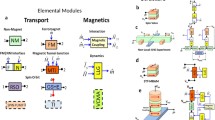Abstract
Spintronics is a new trend in the development of nanoelectronics and, therefore, requires the development of new software tools for modeling aimed at the development and further miniaturization of spintronic devices. In this paper, we present a new software package for the technology computer aided design modeling of spintronic devices based on magnetic tunnel junctions. The theoretical models and scenarios of the software package are described. Examples of application of the software package to solving the main problems arising in the design of magnetoresistive memory elements and consistent miniaturization of these devices are considered.
Similar content being viewed by others
References
M. N. Baibich, J. M. Broto, A. Fert, et al., “Giant magnetoresistance of (001)Fe/(001)Cr magnetic superlattices,” Phys. Rev. Lett. 61, 2472–2475 (1988).
J. S. Moodera, L. R. Kinder, T. M. Wong, et al., “Large magnetoresistance at room temperature in ferromagnetic thin film tunnel junctions,” Phys. Rev. Lett. 74, 3273–3276 (1995).
J. J. M. Ruigrok, R. Coehoorn, S. R. Cumpson, et al., “Disk recording beyond 100 Gb/in.2: Hybrid recording?,” J. Appl. Phys. 87, 5398–5403 (2000).
J. Åkerman, “Toward a universal memory,” Science 308, 508–510 (2005).
A. F. Popkov, K. A. Zvezdin, M. Yu. Chinenkov, et al., “Spin transport and problems of magnetic random access memory (MRAM),” Inzh. Fiz., No. 9, 19–34 (2012).
Y. Chen, H. H. Li, X. Wang, et al., “A 130 nm 1.2/3.3 V 16 kb spin-transfer torque random access memory with nondestructive self-reference sensing scheme,” IEEE J. Solid-State Circuits 47, 560–573 (2012).
B. Dieny, R. Sousa, S. Bandiera, et al., “Extended scalability and functionalities of MRAM based on thermally assisted writing,” in Proceedings of the Electron Devices Meeting IEDM (IEEE Int., 2011), pp. 1.3.1–1.3.4.
www.synopsys.com. Accessed September 29, 2016.
www.silvaco.com. Accessed September 29, 2016.
www.cogenda.com. Accessed September 29, 2016.
www.magoasis.com. Accessed September 29, 2016.
www.goparallel.net. Accessed September 29, 2016.
S. S. P. Parkin, C. Kaiser, A. Panchula, et al., “Giant tunnelling magnetoresistance at room temperature with MgO (100) tunnel barriers,” Nat. Mater. 3, 862–867 (2004).
Y. Huai, “Spin-transfer torque MRAM (STT-MRAM): challenges and prospects,” AAPPS Bull. 18, 33–40 (2008).
M. Miron, K. Garello, G. Gaudin, et al., “Perpendicular switching of a single ferromagnetic layer induced by in-plane current injection,” Nature 476, 189–193 (2011).
Y.-W. Yin, M. Raju, W.-J. Hu, et al., “Multiferroic tunnel junctions,” Front. Phys. 7, 380–385 (2012).
T. Mauyama, Y. Shiota, T. Nozaki, et al., “Large voltage- induced magnetic anisotropy change in a few atomic layers of iron,” Nat. Nanotechnol. 4, 158–161 (2009).
J. Åkerman, M. DeHerrera, M. Durlam, et al., in Magnetic Tunnel Junction Based Magnetoresistive Random Access Memory, Ed. by M. Johnson (Elsevier Academic, Amsterdam, 2004).
J. Deak, “Thermal magnetic random access memory,” in Proceedings of the IEEE International Conference on Computer Design New Memory Technologies, San Jose, CA, Oct. 4, 2005.
B. Purnama, Y. Nozaki, and K. Matsuyama, “Micromagnetic simulation of thermally assisted magnetization reversal in magnetic nanodots with perpendicular anisotropy,” J. Magn. Magn. Mater. 310, 2683–2685 (2007).
D. Pinna, A. Mitra, D. L. Stein, et al., “Thermally assisted spin-transfer torque magnetization reversal in uniaxial nanomagnets,” Appl. Phys. Lett. 101, 262401 (2012).
W. H. Butler, T. Mewes, C. K. A. Mewes, et al., “Switching distributions for perpendicular spin-torque devices within the macrospin approximation,” IEEE Trans. Magn. 48, 4684–4700 (2012).
I. L. Prejbeanu, S. Bandiera, J. Alvarez-Herault, et al., “Thermally assisted MRAMs: ultimate scalability and logic functionalities,” J. Phys. D: Appl. Phys. 46, 074002 (2013).
D. A. Garanin, “Fokker-Planck and Landau-Lifshitz-Bloch equations for classical ferromagnets,” Phys. Rev. B 55, 3050 (1997).
J. Slonczewski, “Current-driven excitation of magnetic multilayers,” J. Magn. Magn. Mater. 159, L1 (1996).
http://www.bitsavers.org/pdf/calma/GDS_II_Users_Operating_Manual_Nov78.pdf. Accessed November 30, 2016.
https://sourceforge.net/projects/netgen-mesher. Accessed September 29, 2016.
https://gitlab.asc.tuwien.ac.at/jschoeberl/ngsolve-docu/wikis/home. Accessed September 29, 2016.
http://www.vtk.org. Accessed September 29, 2016.
http://dakota.sandia.gov. Accessed November 30, 2016.
J. J. Nowak, R. P. Robertazzi, J. Z. Sun, et al., “Dependence of voltage and size on write error rates in spintransfer torque magnetic random-access memory,” IEEE Magn. Lett. 7, 3102604 (2016).
E. C. Stoner and E. P. Wohlfarth, “A mechanism of magnetic hysteresis in heterogeneous alloys,” Philos. Trans. R. Soc. London, Ser. A 240, 599–642 (1948).
P. F. Bessarab, V. M. Uzdin, and H. Jonsson, “Method for finding mechanism and activation energy of magnetic transitions, applied to skyrmion and antivortex annihilation,” Comput. Phys. Commun. 196, 335–347 (2015).
I. L. Prejbeanu, S. Bandiera, J. Alvarez-Herault, et al., “Thermally assisted MRAMs: ultimate scalability and logic functionalities,” J. Phys. D: Appl. Phys. 46, 074002 (2013).
L. M. Loong, X. Qiu, Zh. P. Neo, et al., “Strainenhanced tunneling magnetoresistance in MgO magnetic tunnel junctions,” Sci. Rep. 4, 6505 (2014).
I. M. Iskandarova, A. A. Knizhnik, A. F. Popkov, et al., “Micromagnetic modeling of the shielding properties of nanoscale ferromagnetic layers,” J. Appl. Phys. 120, 123903 (2016).
Author information
Authors and Affiliations
Corresponding author
Additional information
The article is published in the original.
Rights and permissions
About this article
Cite this article
Knizhnik, A.A., Goryachev, I.A., Demin, G.D. et al. A software package for computer-aided design of spintronic nanodevices. Nanotechnol Russia 12, 208–217 (2017). https://doi.org/10.1134/S1995078017020082
Received:
Accepted:
Published:
Issue Date:
DOI: https://doi.org/10.1134/S1995078017020082




